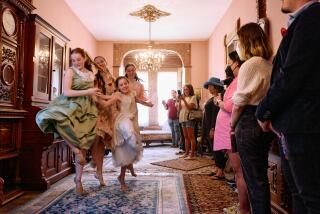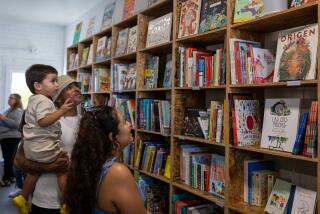Lessons in Living When Storytelling Goes Worldwide
- Share via
To hear Harlynne Geisler tell it, Hansel and Gretel have been sighted around the globe more often than Elvis.
Besides inhabiting the standard locale--a forbidding and vaguely Bavarian forest with a bewitched gingerbread house--the tots have turned up everywhere from a Laotian jungle to a drought-stricken South African plain, Geisler says.
She should know. A professional storyteller for 16 years, Geisler has introduced listeners across North America to a gamut of internationally known characters, including Hansel and Gretel, Rumpelstiltskin, Little Red Riding Hood and assorted giants and princesses. In so doing, she says, she’s helped bring generations and cultures a little closer through the universal language of stories.
“Carl Jung said that there is a bedrock foundation that all stories rest on, which is why you keep seeing the same motif in stories around the world,” she said. “ ‘Hansel and Gretel,’ for example, could be set in Asia or South America or Sweden or Germany, but it will always have the basic elements of children [being] abandoned and an evil character who wants to eat them.”
Geisler, who will perform Irish and Scottish tales Saturday at the Children’s Museum at La Habra, prides herself on her wide repertoire of international stories. She believes that both the listener and the teller benefit from the diversity.
“You don’t want to pigeonhole a person by their cultural background,” said Geisler, who has told Guatemalan stories to preschoolers, Japanese folk tales to adults and will soon teach a workshop on Jewish storytelling to university students. “I might feel a closer affinity to European American stories, because that’s where I come from, but . . . you can easily find a story from anywhere that is going to touch you.”
Geisler, who lives in San Diego, has been telling stories and writing about the storytelling process since the early 1980s, when she gave up a career as a librarian to go full time with her tales. In 1982, she started the Southern California Story-Swapping Festival, an open storytelling session, concert and workshop held in a different Southland city each spring. Next month, she will release her first book, a how-to guide for professional storytellers through Libraries Unlimited Press, and she says she’s thinking about writing children’s picture books based on some lesser-known stories she has told.
“Often, a kid will come up to me after a performance and ask what book I found a particular story in,” she explained. “Unfortunately, many of them are in dusty old collections that no one looks at. By doing the picture books, I could get these great stories out there where kids can get their hands on them.”
Geisler’s Saturday performance is part of the children’s museum’s 1996-97 Storytelling Festival. Sponsored by PacifiCare Foundation, it began last summer and continues through May. Also performing this month is Diane Ferlatte, a nationally known teller who will spin African and African American stories and legends on Jan. 18.
Geisler says her Celtic stories have a special significance for her. In 1993, while telling Scottish ghost stories at the Highland Games in San Diego, she was approached by a man who would later help her establish her link with a centuries-old Scottish clan.
“I’m standing under this tree in this beautiful pastoral setting, and this big bear of a man walks up to me and says, ‘You belong to the clan MacLachlan,’ ” Geisler said.
“He had read in the program that my grandfather’s name was MacLaughlin,” which, he said, was an Irish version of MacLachlan.
“It turns out there was a Norwegian princess in the 1200s or 1300s who married a Scotsman. She was homesick, so they named their son Lachlan, the Gaelic name for Norway, and his son was then MacLachlan, or son of Lachlan, and that’s where it all started.”
Although she never finalizes her program until she gets a look at her audience, Geisler says she expects her La Habra performance will include a favorite Scottish tale about three young girls stolen by a giant. It’s an audience-participation story with a Rumpelstiltskin twist that, she says, is similar to the folk tales that enraptured Scottish families centuries ago.
With the advent of radio, television and film, storytelling lost its lure as popular entertainment. Although it’s slowly regaining an audience, Geisler points out there are still many people, especially in the United States, who consider it just child’s play.
“The founder of NAPS [the National Assn. of Professional Storytellers] put it in perspective pretty well when he said that we have 5,000 members, but the National Turkey Assn. has 50,000 members,” she said with a laugh.
“We are still at the point where we’re educating the public,” she said. “It’s a rare treat when you get that intergenerational audience [of] kids and grandparents and parents all together. That’s when you hope your stories will go home and become part of the family vocabulary . . . where Mom might say, ‘Hey, do your chores, or that giant may come over and get you!’ ”
* What: Irish and Scottish stories told by Harlynne Geisler.
* When: Saturday at noon.
* Where: Children’s Museum at La Habra, 301 S. Euclid St., La Habra.
* Whereabouts: From the Orange (57) Freeway, exit at Lambert Road and drive west. Turn right on Euclid.
* Wherewithal: Performance is free with museum admission: $4, under 2 is free.
* Where to call: (310) 905-9793.


